Influences of Pulse Shaping on Single-Track Clad of AISI316L Stainless Steel by Laser Material Deposition
Abstract
:1. Introduction
2. Materials and Methods
2.1. Materials
2.2. Experimental Set-Up
2.3. Pulse Shaping and Parameters
2.4. Characterization Techniques
3. Results
3.1. Geometrical Characteristics
3.2. Microstructure
3.3. Microhardness
4. Conclusions
- The maximum dimensions of width, height, and depth were presented when the continuous laser shape was used because of the high laser energy input which can create a big molten pool to capture much powder. Under the condition of ramp up laser shape, the minimum values of the dimensions were shown. The results could be explained by the low laser energy input and the feature of gradual heating which restricted the growth of the molten pool in the beginning of the laser pulse. In addition, the dimension of geometric characteristics was approximate between the rectangular and hybrid ramp laser shapes owing to the approximate equivalence pulse energy.
- The microstructure of depositions presented the typical solidified features, meaning the plane crystal near the interface followed by the columnar cellular near the middle and the cellular crystal near the top. The continuous laser shape produced the coarsest microstructure with the biggest grain size as a result of the lowest cooling rate. Owing to the gradual heating in ramp up and gradual cooling in ramp down, the cooling rates were restrained under these two types of laser shape. Therefore, the smallest grain size that occurred when the rectangular laser shape was used can be attributed to the highest cooling rate.
- The rules of microhardness were well matched with the results of microstructure. The maximum average hardness of deposition was presented in the condition of rectangular laser shape because of the smallest grain size created by the biggest cooling rate. The coarse microstructure of deposition created by the continuous laser shape resulted in the lowest hardness owing to the lowest cooling rate. In addition, the average hardness of deposition created by hybrid ramp was lower than that by ramp up and ramp down. Furthermore, it was slightly larger than that of continuous laser shape because hybrid ramp can be seen as a continuous laser shape with varied laser energy.
- It can be concluded that pulse shaping has significant effects on the geometrical characteristics, microstructure, and microhardness of single-track clads deposited by LAM by affecting the laser energy input and the molten pool. In particular, the heating and cooling of the molten pool, which have serious impacts on residual stress, are closely related to the laser shape. Based on the research about single-track clad reported by this article, the investigation in regard to the effects of pulse shaping on the properties of multi-track and multi-layer depositions will be conducted in the near future.
Author Contributions
Funding
Institutional Review Board Statement
Informed Consent Statement
Data Availability Statement
Conflicts of Interest
References
- Ri-sheng, L.; Shao-ni, S.; Zi-sheng, L. The influence of scanning methods on the cracking failure of thin-wall metal parts fabricated by laser direct deposition shaping. Eng. Fail. Anal. 2016, 59, 269–278. [Google Scholar] [CrossRef]
- Shah, K.; Pinkerton, A.J.; Salman, A.; Li, L. Effects of melt pool variables and process parameters in laser direct metal deposition of aerospace alloys. Mater. Manuf. Processes 2010, 25, 1372–1380. [Google Scholar] [CrossRef] [Green Version]
- Wang, X.; Liu, Z.; Guo, Z.; Hu, Y. A fundamental investigation on three–dimensional laser material deposition of AISI316L stainless steel. Opt. Laser Technol. 2020, 126, 106107. [Google Scholar] [CrossRef]
- Shishkovsky, I.; Missemer, F.; Smurov, I. Direct metal deposition of functional graded structures in Ti- Al system. Physics Procedia 2012, 39, 382–391. [Google Scholar] [CrossRef] [Green Version]
- Shah, K.; Haq, I.U.; Khan, A.; Shah, S.A.; Khan, M.; Pinkerton, A.J. Parametric study of development of Inconel-steel functionally graded materials by laser direct metal deposition. Mater. Des. 2013, 54, 531–538. [Google Scholar] [CrossRef]
- Shifeng, W.; Shuai, L.; Qingsong, W.; Yan, C.; Sheng, Z.; Yusheng, S. Effect of molten pool boundaries on the mechanical properties of selective laser melting parts. J. Mater. Processing Technol. 2014, 214, 2660–2667. [Google Scholar] [CrossRef]
- El Cheikh, H.; Courant, B.; Branchu, S.; Huang, X.; Hascoët, J.-Y.; Guillén, R. Direct laser fabrication process with coaxial powder projection of 316L steel. Geometrical characteristics and microstructure characterization of wall structures. Opt. Lasers Eng. 2012, 50, 1779–1784. [Google Scholar] [CrossRef] [Green Version]
- Wang, X.; Deng, D.; Qi, M.; Zhang, H. Influences of deposition strategies and oblique angle on properties of AISI316L stainless steel oblique thin-walled part by direct laser fabrication. Opt. Laser Technol. 2016, 80, 138–144. [Google Scholar] [CrossRef]
- Shrivastava, A.; Mukherjee, S.; Chakraborty, S.S. Addressing the challenges in remanufacturing by laser-based material deposition techniques. Opt. Laser Technol. 2021, 144, 107404. [Google Scholar] [CrossRef]
- Zhang, K.; Liu, W.; Shang, X. Research on the processing experiments of laser metal deposition shaping. Opt. Laser Technol. 2007, 39, 549–557. [Google Scholar] [CrossRef] [Green Version]
- Bian, L.; Thompson, S.M.; Shamsaei, N. Mechanical properties and microstructural features of direct laser-deposited Ti-6Al-4V. JOM 2015, 67, 629–638. [Google Scholar] [CrossRef]
- Farahmand, P.; Kovacevic, R. An experimental–numerical investigation of heat distribution and stress field in single- and multi-track laser cladding by a high-power direct diode laser. Opt. Laser Technol. 2014, 63, 154–168. [Google Scholar] [CrossRef]
- Wang, X.; Lei, L.; Yu, H. A Review on microstructural features and mechanical properties of wheels/rails cladded by laser cladding. Micromachines 2021, 12, 152. [Google Scholar] [CrossRef]
- Calleja, A.; Tabernero, I.; Fernández, A.; Celaya, A.; Lamikiz, A.; López de Lacalle, L.N. Improvement of strategies and parameters for multi-axis laser cladding operations. Opt. Lasers Eng. 2014, 56, 113–120. [Google Scholar] [CrossRef]
- Mumtaz, K.; Hopkinson, N. Selective laser melting of thin wall parts using pulse shaping. J. Mater. Processing Technol. 2010, 210, 279–287. [Google Scholar] [CrossRef]
- Moat, R.J.; Pinkerton, A.J.; Li, L.; Withers, P.J.; Preuss, M. Residual stresses in laser direct metal deposited Waspaloy. Mater. Sci. Eng. A 2011, 528, 2288–2298. [Google Scholar] [CrossRef]
- Kahlen, F.-J.; Kar, A. Residual stresses in laser-deposited metal parts. J. Laser Appl. 2001, 13, 60–69. [Google Scholar] [CrossRef]
- Chunhua, T.; Yonglei, Z. Experimental study on laser cladding of Ni60 alloy powder. Appl. Laser 2010, 30, 386–390. [Google Scholar] [CrossRef]
- Sun, S.; Durandet, Y.; Brandt, M. Parametric investigation of pulsed Nd: YAG laser cladding of stellite 6 on stainless steel. Surf. Coat. Technol. 2005, 194, 225–231. [Google Scholar] [CrossRef]
- Toyserkani, E.; Khajepour, A.; Corbin, S. 3-D finite element modeling of laser cladding by powder injection: Effects of laser pulse shaping on the process. Opt. Lasers Eng. 2004, 41, 849–867. [Google Scholar] [CrossRef]
- Dong, S.Y.; Ren, W.B.; Bin-Shi, X.U.; Yan, S.X.; Fang, J.X. Experiment optimization of impulse laser remanufacture forming process for compresssor thin-wall blade. J. Acad. Armored Force Eng. 2015, 005, 97–101. [Google Scholar]
- Gharbi, M.; Peyre, P.; Gorny, C.; Carin, M.; Morville, S.; Le Masson, P.; Carron, D.; Fabbro, R. Influence of a pulsed laser regime on surface finish induced by the direct metal deposition process on a Ti64 alloy. J. Mater. Processing Technol. 2014, 214, 485–495. [Google Scholar] [CrossRef] [Green Version]
- Wang, L.; Felicelli, S.D.; Pratt, P. Residual stresses in LENS-deposited AISI 410 stainless steel plates. Mater. Sci. Eng. A 2008, 496, 234–241. [Google Scholar] [CrossRef]
- Wang, X.; Deng, D.; Yi, H.; Xu, H.; Yang, S.; Zhang, H. Influences of pulse laser parameters on properties of AISI316L stainless steel thin-walled part by laser material deposition. Opt. Laser Technol. 2017, 92, 5–14. [Google Scholar] [CrossRef]
- Rangaswamy, P.; Griffith, M.L.; Prime, M.B.; Holden, T.M.; Rogge, R.B.; Edwards, J.M.; Sebring, R.J. Residual stresses in LENS® components using neutron diffraction and contour method. Mater. Sci. Eng. A 2005, 399, 72–83. [Google Scholar] [CrossRef]
- Weedon, T. Nd-YAG lasers with controlled pulse shape. Proc. LAMP 1987, 87, 75–80. [Google Scholar]
- Sparks, T.; Ruan, J.; Fan, Z.; Bao, Y.; Liou, F. Effect of structured laser pulses on grain growth in H13 tool steel. In Proceedings of the 2006 International Solid Freeform Fabrication Symposium, Austin, TX, USA, 14–16 August 2006. [Google Scholar]
- Bransch, H.; Weckman, D.; Kerr, H. Effects of Pulse Shaping on Nchyag Spot Welds in Austenitic Stainless Steel; US Department of Energy: Washington, DC, USA, 1994.
- Alimardani, M.; Toyserkani, E.; Huissoon, J.P.; Paul, C.P. On the delamination and crack formation in a thin wall fabricated using laser solid freeform fabrication process: An experimental–numerical investigation. Opt. Lasers Eng. 2009, 47, 1160–1168. [Google Scholar] [CrossRef]
- Wang, X.; Deng, D.; Hu, Y.; Liu, Z.; Zhang, H. Analytical modeling and experimental investigation of laser clad geometry. Opt. Eng. 2017, 56, 1. [Google Scholar] [CrossRef]
- Alimardani, M.; Toyserkani, E. Prediction of laser solid freeform fabrication using neuro-fuzzy method. Appl. Soft Comput. 2008, 8, 316–323. [Google Scholar] [CrossRef]
- Zhang, X.; Cao, Z. Effects of pulse shaping on Nd:YAG laser spot welds in an AZ31 magnesium alloy. Opt. Lasers Eng. 2019, 119, 1–8. [Google Scholar] [CrossRef]
- Chandra, S.; Rao, B.C. A study of process parameters on workpiece anisotropy in the laser engineered net shaping (LENSTM) process. J. Phys. D Appl. Phys. 2017, 50, 225303. [Google Scholar] [CrossRef]
- Shamsaei, N.; Yadollahi, A.; Bian, L.; Thompson, S.M. An overview of direct laser deposition for additive manufacturing; Part II: Mechanical behavior, process parameter optimization and control. Addit. Manuf. 2015, 8, 12–35. [Google Scholar] [CrossRef]
- Selcuk, C. Laser metal deposition for powder metallurgy parts. Powder Metall. 2011, 54, 94–99. [Google Scholar]
- Vilar, R. Laser cladding. Laser Appl. 2001, 11, 64–79. [Google Scholar] [CrossRef]
- Ma, M.; Wang, Z.; Gao, M.; Zeng, X. Layer thickness dependence of performance in high-power selective laser melting of 1Cr18Ni9Ti stainless steel. J. Mater. Processing Technol. 2015, 215, 142–150. [Google Scholar] [CrossRef]
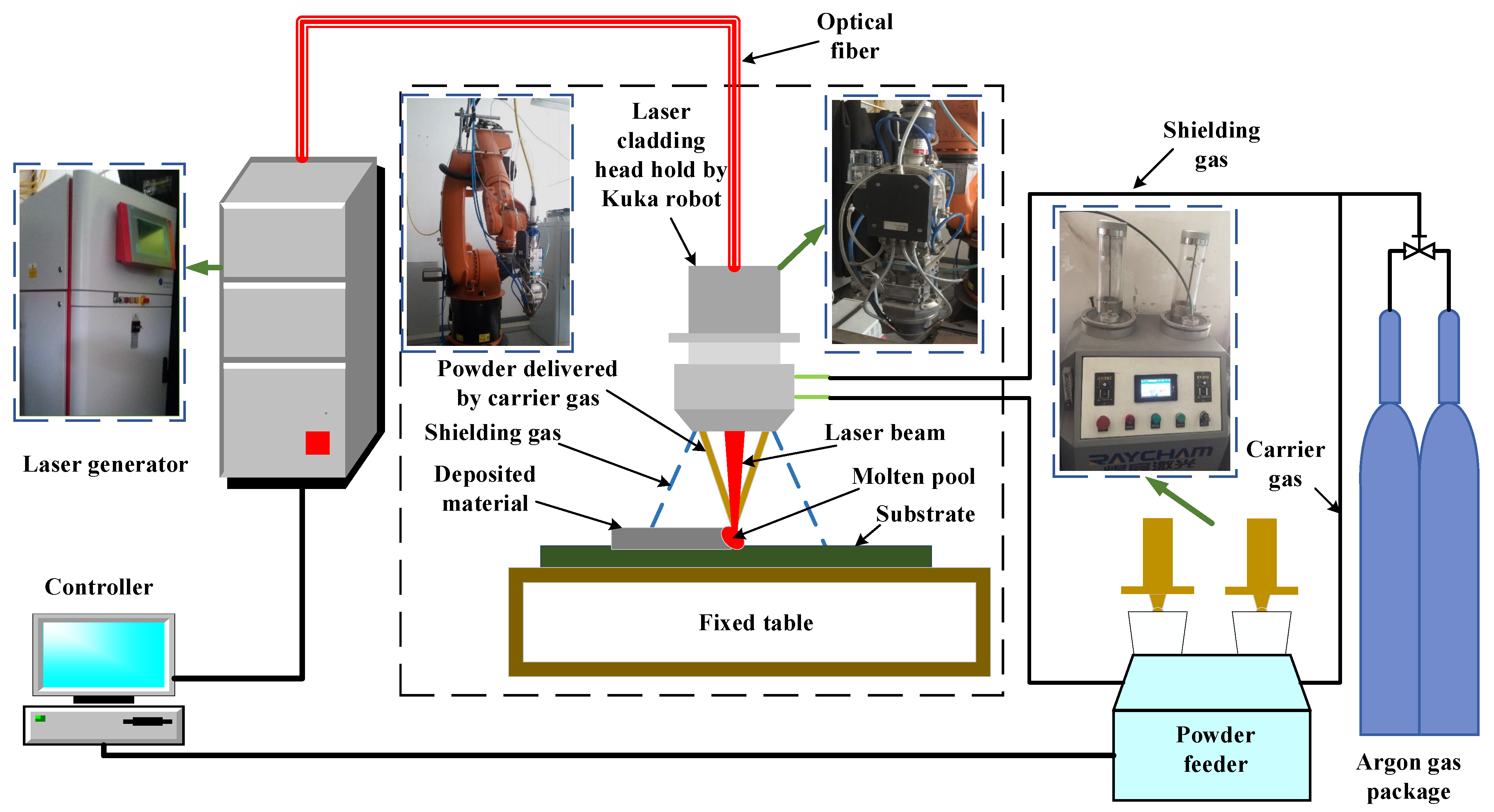
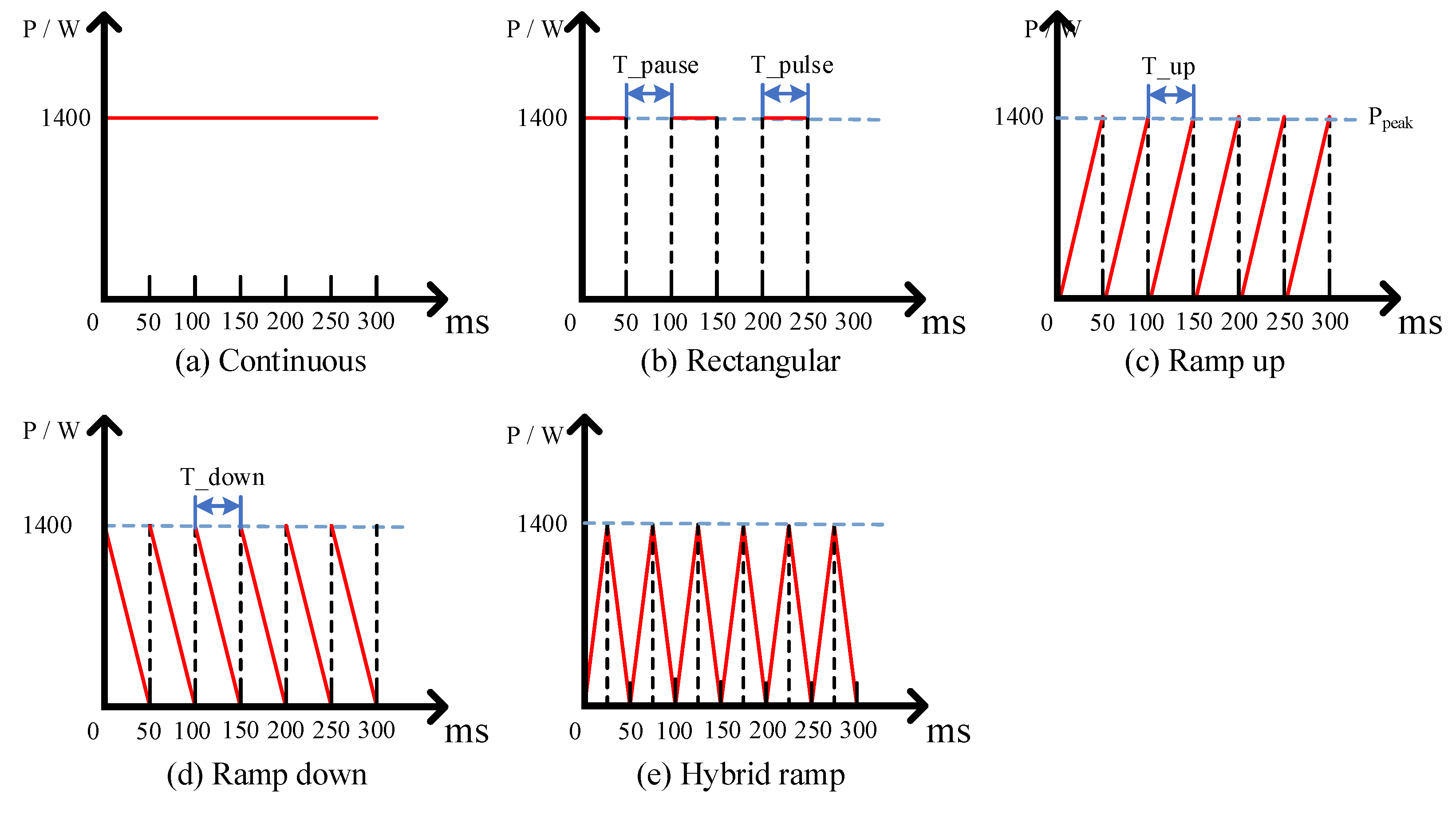
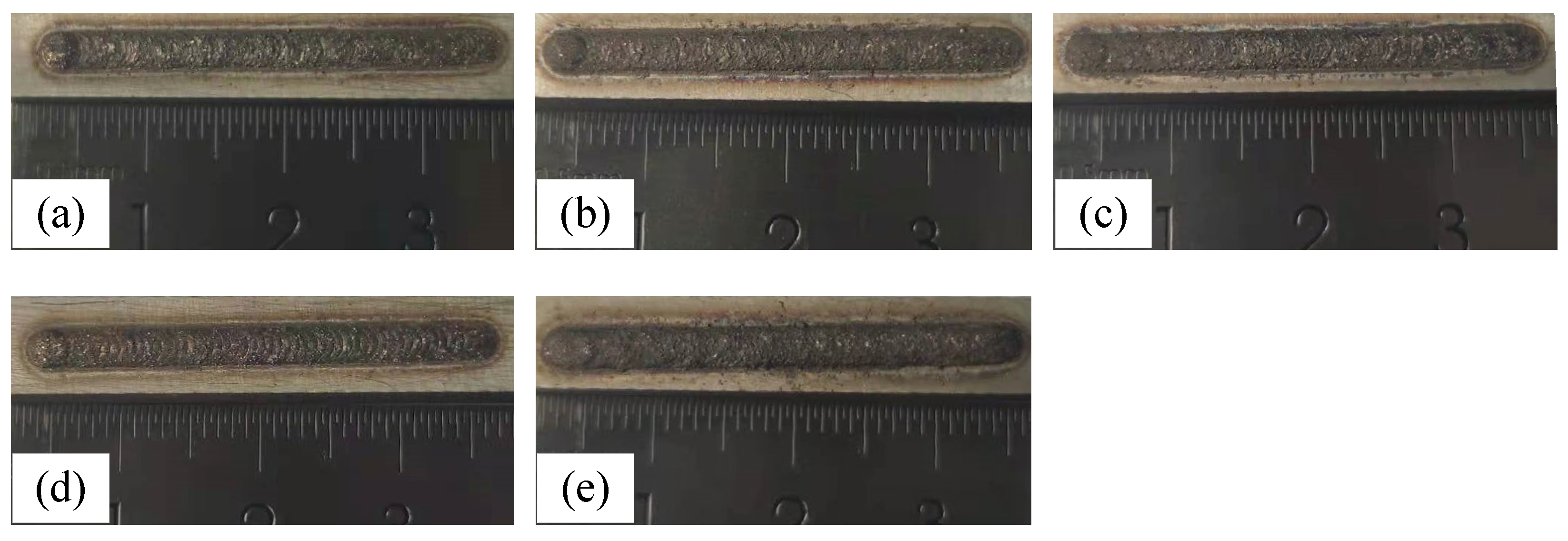
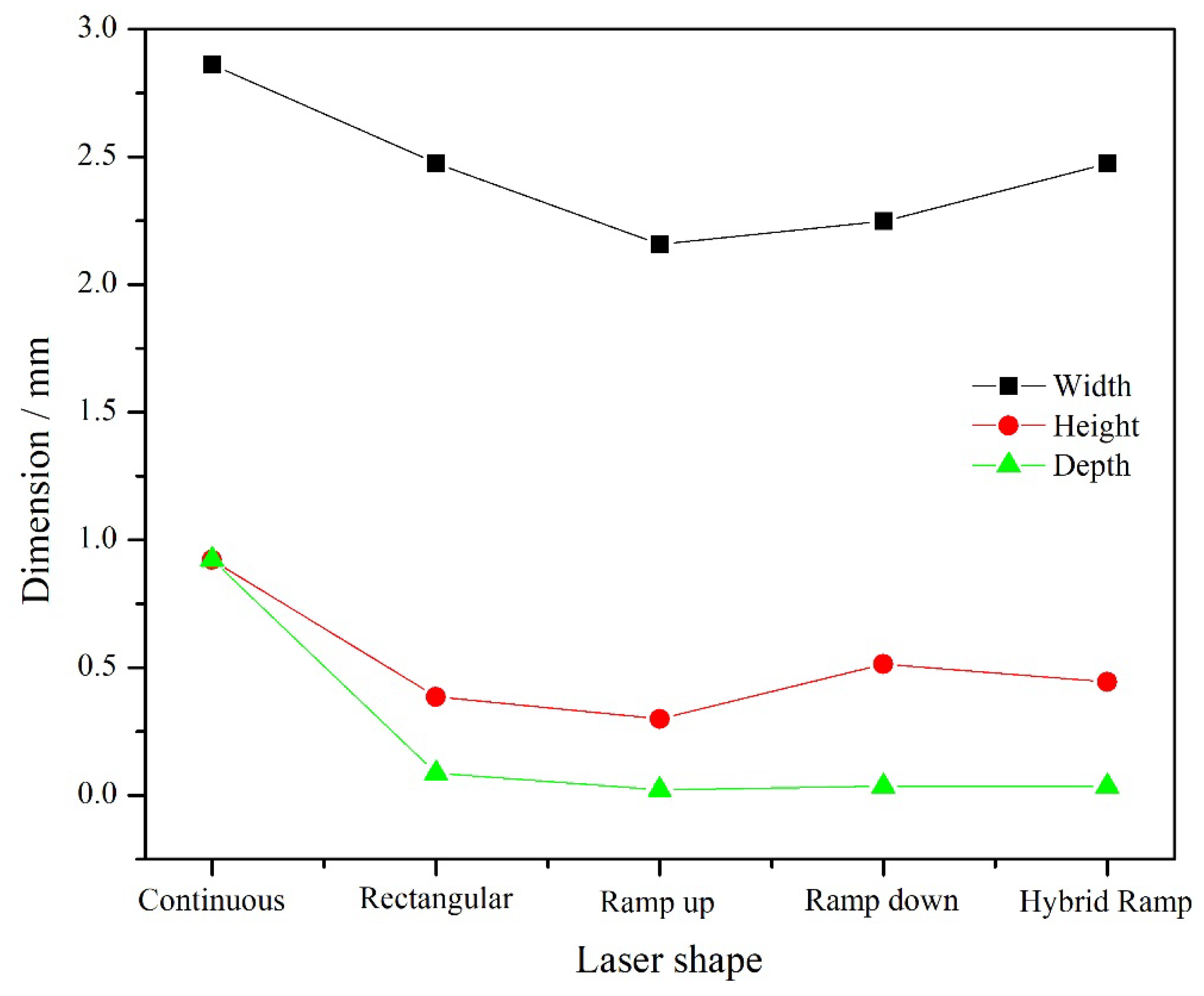
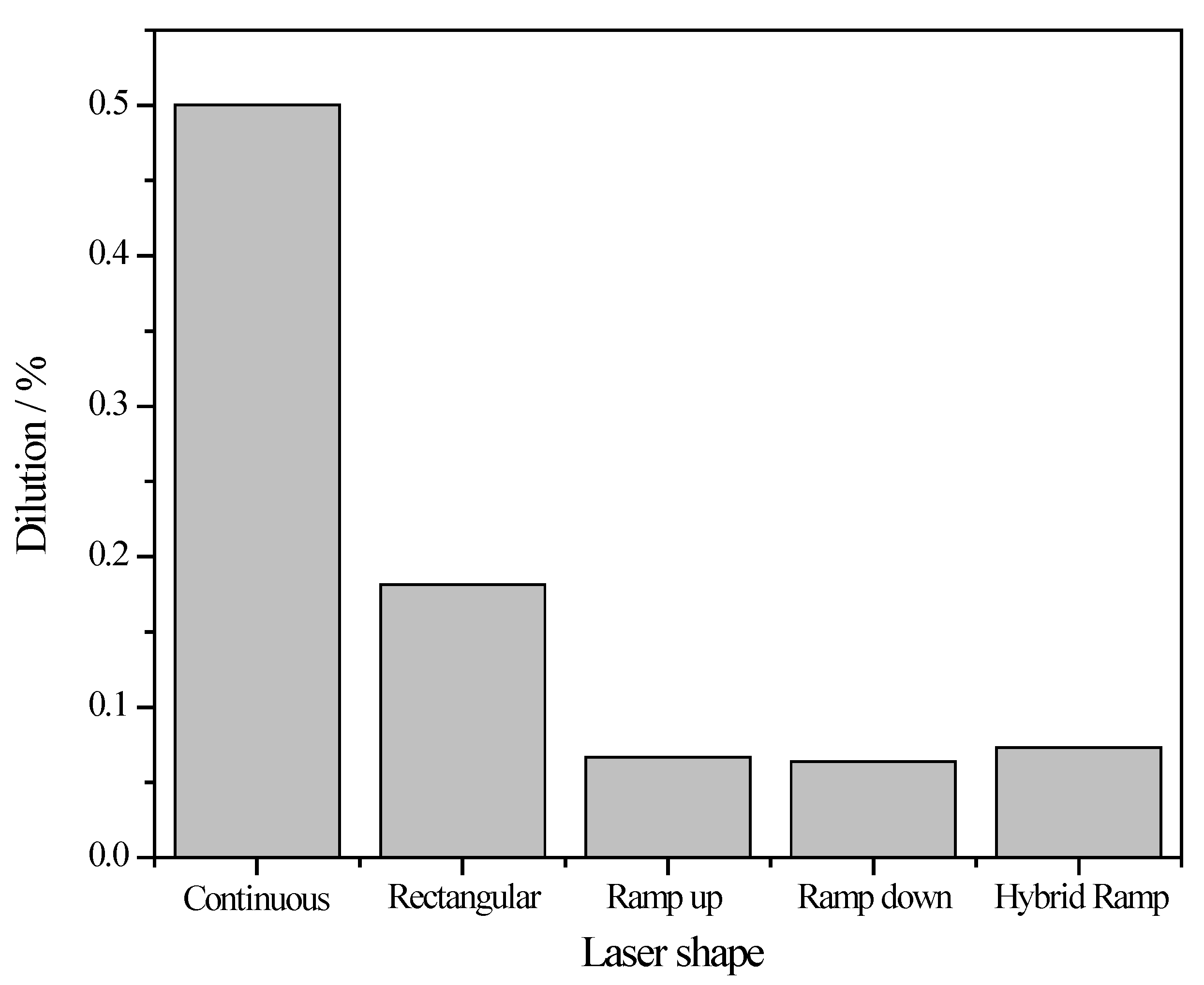
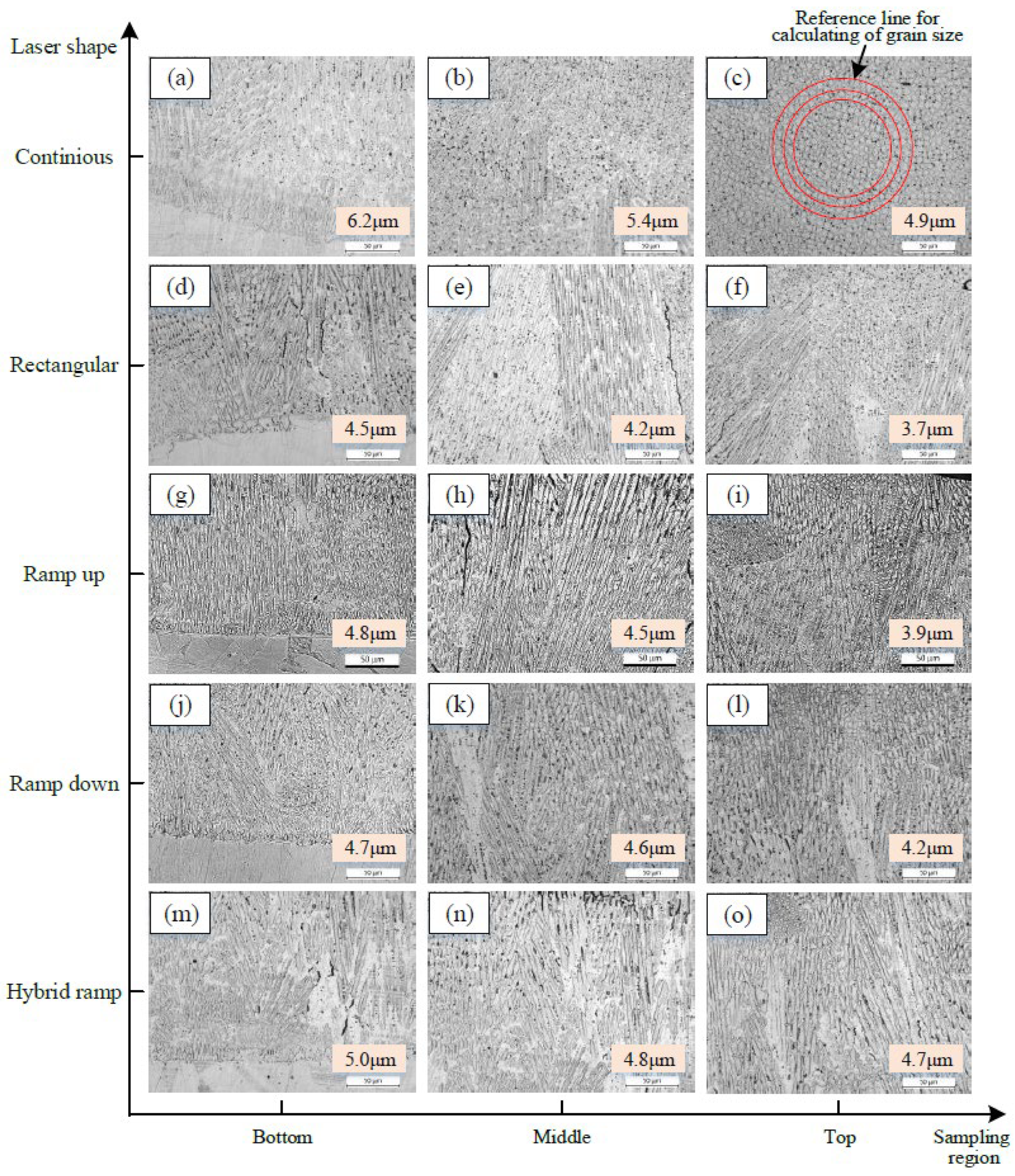

| Element | C | Mo | Ni | Mn | Cr | Si | Fe |
|---|---|---|---|---|---|---|---|
| Wt.% | 0.003 | 2.6 | 12.5 | 1.5 | 16.8 | 0.6 | Bal. |
| Factor | Types of Laser Shape | ||||
|---|---|---|---|---|---|
| Continuous | Rectangular | Ramp Up | Ramp Down | Hybrid Ramp | |
| Ppeak (W) | 1400 | ||||
| V (mm/s) | 6 | ||||
| Qm (g/s) | 0.078 | ||||
| T_pulse (ms) | +∞ | 25 | 25 | 25 | 50 |
| T_pause (ms) | 0 | 25 | 25 | 25 | 0 |
| T_up (ms) | 0 | 0 | 25 | 0 | 25 |
| T_down (ms) | 0 | 0 | 0 | 25 | 25 |
Publisher’s Note: MDPI stays neutral with regard to jurisdictional claims in published maps and institutional affiliations. |
© 2022 by the authors. Licensee MDPI, Basel, Switzerland. This article is an open access article distributed under the terms and conditions of the Creative Commons Attribution (CC BY) license (https://creativecommons.org/licenses/by/4.0/).
Share and Cite
Wang, X.; Yu, H.; Jiang, J.; Xia, C.; Zhang, Z. Influences of Pulse Shaping on Single-Track Clad of AISI316L Stainless Steel by Laser Material Deposition. Coatings 2022, 12, 248. https://doi.org/10.3390/coatings12020248
Wang X, Yu H, Jiang J, Xia C, Zhang Z. Influences of Pulse Shaping on Single-Track Clad of AISI316L Stainless Steel by Laser Material Deposition. Coatings. 2022; 12(2):248. https://doi.org/10.3390/coatings12020248
Chicago/Turabian StyleWang, Xinlin, Han Yu, Jinkun Jiang, Chengui Xia, and Zengxia Zhang. 2022. "Influences of Pulse Shaping on Single-Track Clad of AISI316L Stainless Steel by Laser Material Deposition" Coatings 12, no. 2: 248. https://doi.org/10.3390/coatings12020248
APA StyleWang, X., Yu, H., Jiang, J., Xia, C., & Zhang, Z. (2022). Influences of Pulse Shaping on Single-Track Clad of AISI316L Stainless Steel by Laser Material Deposition. Coatings, 12(2), 248. https://doi.org/10.3390/coatings12020248






